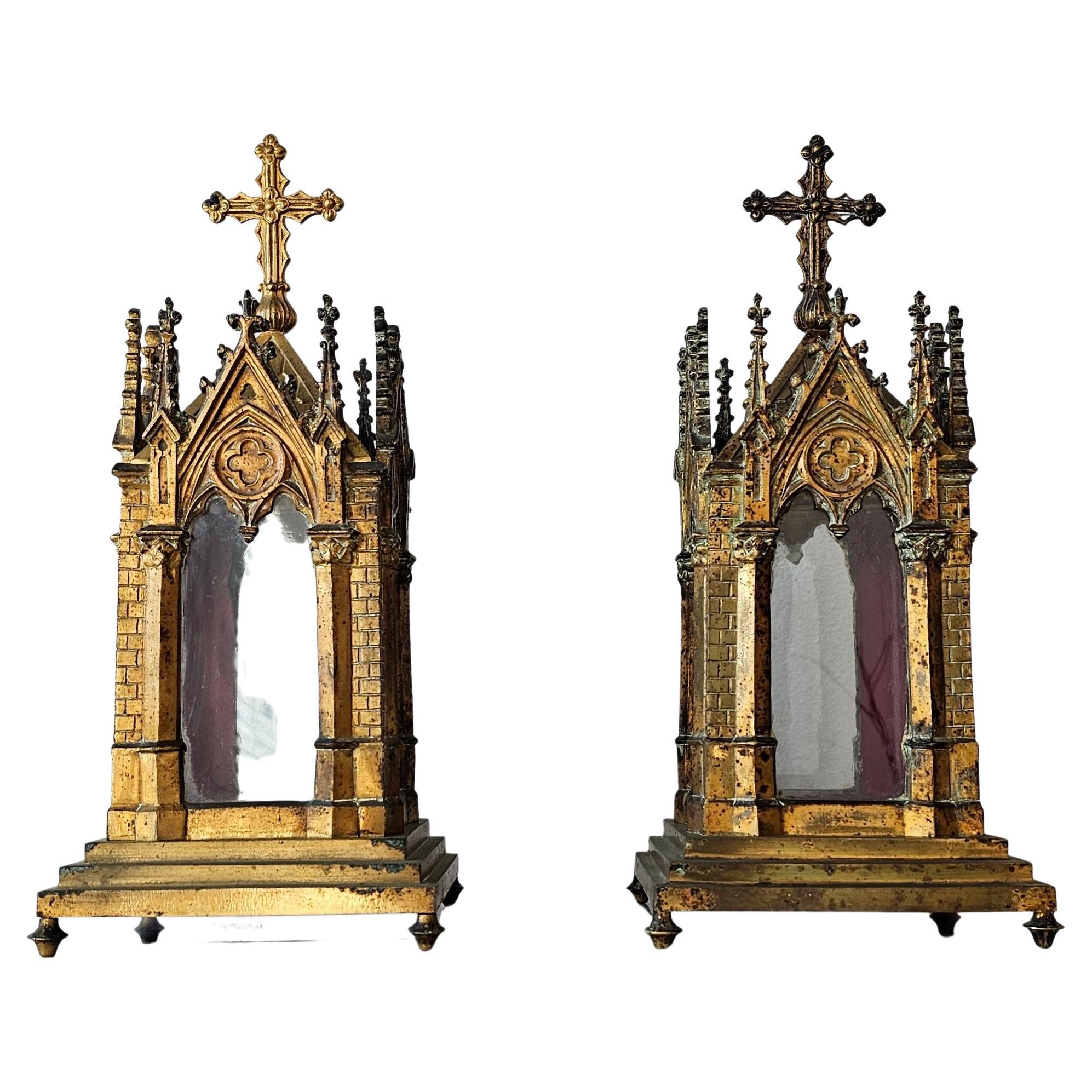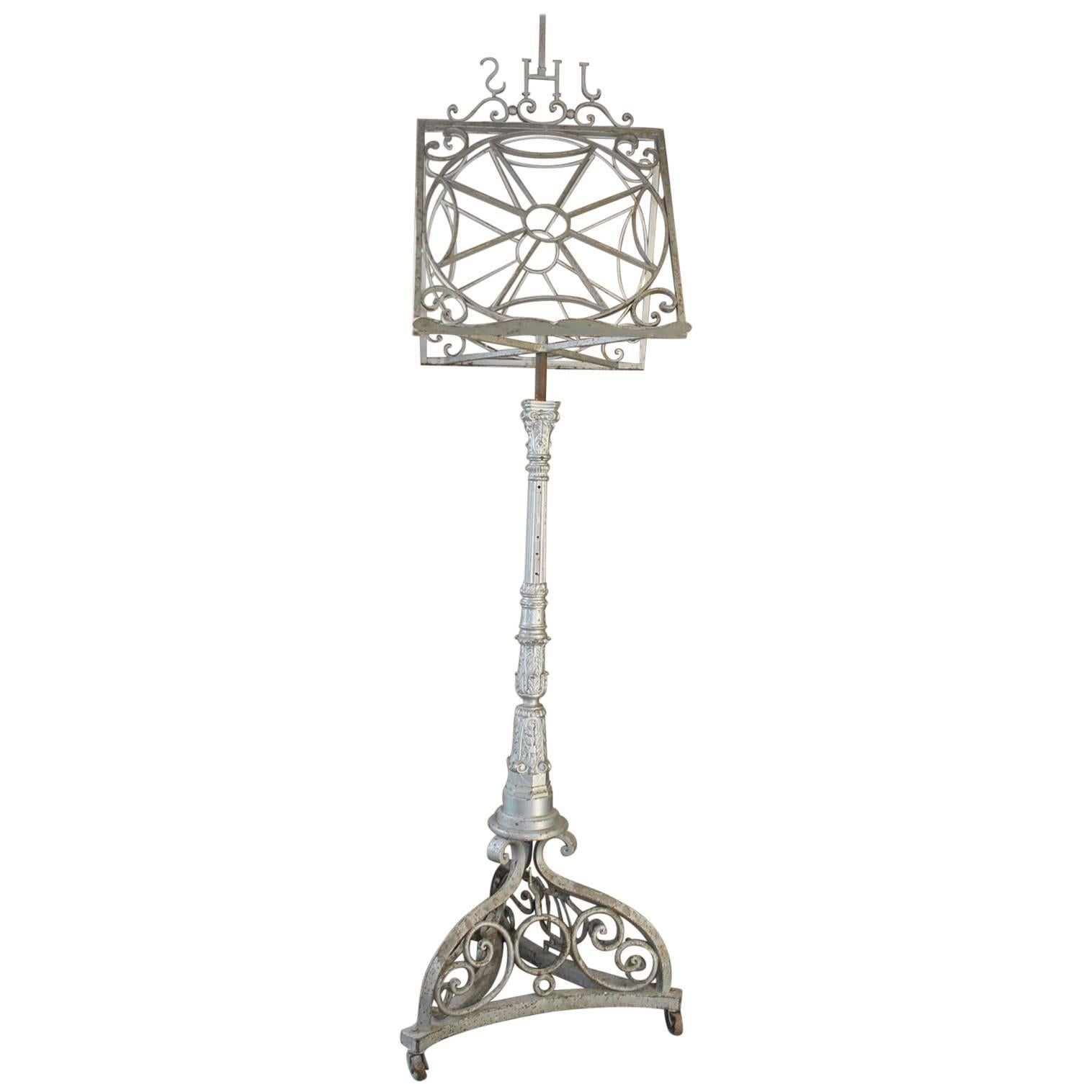Items Similar to A rare and large church stoup in the shape of a shell. France 19th century.
Want more images or videos?
Request additional images or videos from the seller
1 of 9
A rare and large church stoup in the shape of a shell. France 19th century.
About the Item
This unique and substantial church entrance stoup is expertly crafted in the elegant shape of a shell, originating from a historic 19th-century French church. Constructed from durable cast iron, it boasts a superb patina that only time can bestow, adding to its allure and historical charm. Traditionally used as a holy water font, it serves as a vessel containing holy water, placed near the entrance of a church for worshippers to use in making the sign of the cross upon entering. However, its versatile design allows it to serve alternative purposes, such as a stylish fruit bowl or a distinctive pocket tray, making it a versatile and captivating addition to any setting. Whether used for its original religious function or repurposed as a decorative accent, this piece carries with it a sense of reverence and antiquity, enriching any space with its presence.
- Dimensions:Height: 3.94 in (10 cm)Width: 18.9 in (48 cm)Depth: 16.93 in (43 cm)
- Style:Gothic Revival (In the Style Of)
- Materials and Techniques:Steel,Molded
- Place of Origin:
- Period:
- Date of Manufacture:Unknown
- Condition:
- Seller Location:SOTTEVILLE-LÈS-ROUEN, FR
- Reference Number:1stDibs: LU7052238777352
About the Seller
5.0
Platinum Seller
These expertly vetted sellers are 1stDibs' most experienced sellers and are rated highest by our customers.
Established in 2012
1stDibs seller since 2022
17 sales on 1stDibs
Typical response time: 1 hour
- ShippingRetrieving quote...Ships From: SOTTEVILLE-LÈS-ROUEN, France
- Return PolicyA return for this item may be initiated within 3 days of delivery.
More From This SellerView All
- A wooden church pedestal France 19th centuryLocated in SOTTEVILLE-LÈS-ROUEN, FRA french church pedestal from the 19th or early 20th century, made of solid pine, with an original cream-colored patina adorned with gilding. Despite some minor losses, it remains v...Category
Early 20th Century French Gothic Revival Pedestals and Columns
MaterialsPine
- A vintage lifebuoy from a French ship, early 20th century.Located in SOTTEVILLE-LÈS-ROUEN, FRA vintage lifebuoy from a French ship, dating back to the early 20th century. It features a cork core covered with white and red fabric and equipped with a lifeline. It has a brass r...Category
Early 20th Century French Nautical Objects
MaterialsBrass
- A carved and waxed wooden satyr face, France 19th centuryLocated in SOTTEVILLE-LÈS-ROUEN, FRA carved and waxed wooden satyr face, originating from France in the 19th century.Category
Antique Late 19th Century European Figurative Sculptures
MaterialsWood
- A pair of ostrich eggs with their turned solid oak bases, France XIXth centuryLocated in SOTTEVILLE-LÈS-ROUEN, FRA pair of emptied ostrich eggs with their turned solid oak bases, dating back to the 19th century and originating from a cabinet of curiosities, Ostrich eggs are particularly impres...Category
Antique Late 19th Century French Taxidermy
MaterialsOstrich Eggshell, Oak
- A classic blown and cut glass water carafe - France, 19th century.Located in SOTTEVILLE-LÈS-ROUEN, FRA classic blown and cut glass water carafe - France, 19th century. total height : 35cm.Category
Antique Mid-19th Century Glass
MaterialsBlown Glass
- A footstool from the early 20th century - turned wood and caning - France.By Thonet, Atelier HofmannLocated in SOTTEVILLE-LÈS-ROUEN, FRA footrest from the early 20th century, made of solid turned wood and caning. In excellent condition with a beautiful patina.Category
Vintage 1920s French Footstools
MaterialsCane, Wood
You May Also Like
- Brooch in the Shape of a Cross 19th Century 19th CenturyBy Europa AntiquesLocated in Madrid, ESBrooch in the shape of a cross xix century It is made of wood and golden metal. Measures: 8 x 5 cm Good condition.Category
Antique 19th Century Italian Gothic Religious Items
MaterialsBronze
- Fine 19th Century French Neo-Gothic Gilt Metal Cathedral Church Reliquary PairLocated in Forney, TXA stunning pair of very fine quality French Neo-Gothic gilt metal church reliquaries. circa 1860s Most impressive objets d’art, born in France in the second half of the 19th century, most likely Parisian gilded bronze and brass ormolu work, exceptionally executed sculptural form, the exquisitely detailed architectural cathedral shaped case having a removable pointed steeple roof with cross finial, opening to relic display case surrounded on all sides by original glazed glass panes, stepped base, rising on disc feet. Signed, stamped by maker / bronzier "BC" (unknown) model "5096" and other faint marks to lid interiors. Additional photos available upon request Dimensions: (approx) 14.75" High, 6.75" Wide, 6.75" Deep; 13.25 lbs total History: A reliquary (also referred to as a shrine, by the French term châsse or monstrance) is a container for important religious relics. The earliest reliquaries were essentially boxes, either simply box-shaped or based on an architectural design, taking the form of a model of a church with a pitched roof. These latter are known by the French term chasse, and typical examples from the 12th to 14th century have wooden frameworks with gilt-copper plaques nailed on, decorated in champlevé enamel. Limoges was the largest production centre; NB the English usage differs from that of the French châsse, which denotes large size rather than shape. Relics of the True Cross became very popular from the 9th century onward and were housed in magnificent gold and silver cross-shaped reliquaries decorated with enamels and precious stones. From about the end of the 10th century, reliquaries in the shape of the relics they housed also became popular; hence, for instance, the skull of Pope Alexander I was housed in a head-shaped reliquary. Similarly, the bones of saints were often housed in reliquaries that recalled the shape of the original body part, such as an arm or a foot. A philatory is a transparent reliquary designed to contain and exhibit the bones and relics of saints. This style of reliquary has a viewing portal to view the relic inside. The feretrum was a medieval form of reliquary or shrine containing the sacred effigies and relics of a saint. During the later Middle Ages, the monstrance form, primarily used for consecrated hosts, was sometimes used for reliquaries. These housed the relic in a rock crystal, or glass capsule mounted on a column above a base, enabling the relic to be displayed to the faithful. Reliquaries in the form of large pieces of metalwork jewellery also appeared around this time, housing tiny relics such as pieces of the Holy Thorn, notably the Holy Thorn Reliquary now in the British Museum. Condition: Superb museum quality examples, in excellent original unrestored antique condition with beautifully aged patina. Wear consistent with age and use. Heavily patinated - scattered oxidation. Overall wonderful examples. Typically reliquaries were not sold in pairs, so to find a matching pair such as this is exceptionally rare. Worldwide shipping available Local pickup available near Dallas, Texas Additional: We here at Lynx Hollow Antiques love religious antiques, from Christian tabernacles, Catholic altarpiece, life-size Buddhist temple sculptures, Hindu votive offerings, 16th century Islamic mosque architectural salvaged windows...Category
Antique Mid-19th Century French Gothic Revival Religious Items
MaterialsBrass, Bronze
- Unique and Quality Carved Gothic Revival Oak Church Stool Seat, 19th CenturyLocated in Lisse, NLAntique, stunning and practical Gothic stool with a seat pillow with tassels. This striking and perfect size Gothic stool is as stable as the day it was handmade & hand-carved and t...Category
Antique Late 19th Century Dutch Gothic Revival Religious Items
MaterialsVelvet, Oak, Fabric
- 19th Century Silver Loderein Box in the Shape of a BookLocated in Delft, NLA 19th century silver loderein box in the shape of a book A silver loderein box in the shape of a book with engraving. 19th century. Under the box hallmarked with the silver hal...Category
Antique 19th Century Models and Miniatures
MaterialsSilver
- 19th Century French Gothic Sacrament CabinetLocated in Dallas, TX19th Century French Gothic Sacrament cabinet was artfully sculpted from solid oak and fruitwood to create a remarkable religious artifact designed to be appreciated throughout the ages! The trapezoidal form of the casework is in keeping with the Gothic style, which historians concur originated in the Cathedral of St. Denis during the middle of the 12th century. Boldly molded crown follows the complex contours and overlooks the case below which features a single door flanked by cornerposts that feature pilasters facing front as well as the sides, with recessed arched panels topped with recessed circular frames above filled with carved rosettes highlighted in gold. The arched recesses facing the front are also filled with carved floral and wheat motifs also highlighted in gold, representing the Bread of Life. The door panel, however, steals the show, with a gloriously carved relief work depicting both wheat and fully laden grapevines adding the significance of the Blood of Christ...Category
Antique Mid-19th Century French Gothic Revival Religious Items
MaterialsFruitwood, Oak
- Antique Church Lectern from the Early 19th CenturyLocated in Udenhout, NLThe French Churches and Chapels were using these religious lecterns from which the Holy Bible was read.Category
Antique Early 19th Century French Religious Items
MaterialsIron





